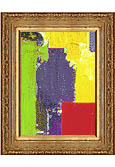Recently a close friend of mine visited the Isabella Stewart Gardner Museum in Boston. While admiring the tremendous collection, he happened upon several vacant wall spaces that represented the last known resting places for several important pieces of art, stolen from the Museum in a late night theft. Upon returning from the Museum, his first question for me was: Who owns the artwork if it mysteriously appears in a gallery or auction house?
Believe it or not, a “black market” exists for the sale and purchase of expensive, rare, and stolen works of art. After time, most stolen pieces will reappear on the scene. This reappearance may not occur for many years or even centuries. However, when the works do emerge, a number of people, undoubtedly, claim ownership.
When a collector inquires about the purchase of a rare and expensive piece of art, or any piece of art for that matter, I always advise him or her to closely examine the chain of title of the work. As a matter of case law and statute, in the United States of America, even if you are a bona fide purchaser, if a work of art is later found to be stolen, the work can be taken from the purchaser or unauthorized “owner”. (This is not necessarily the case in Europe, where a purchaser will most likely be able to keep the stolen work and avoid facing the prospect of losing the artwork.) (I)
All collectors, both active buyers and collectors who have had items stolen, need to have a basic understanding of Massachusetts law with regard to stolen property and artwork. Below I have briefly outlined issues that need to be addressed both when buying art and when attempting to recover stolen artwork.



Under Massachusetts and United States law, in general, a purchaser cannot take good title from a thief. (II) Often times a naïve collector will automatically assume that if an art gallery or a person claiming to be an “art broker” offers a piece of artwork for sale, that they have ownership and the right and authority to sell the work. This is not always the case. Massachusetts case law has supported the notion that mere possession of a chattel does not vest the individual with the apparent authority to sell. (III) In fact, the trend throughout the United States is a frightening one for collectors. American collectors who unknowingly purchase stolen art, more likely than not, will lose the artwork with little to no compensation. According to an article in the November 5, 1999 edition of the Wall Street Journal by Ken Bensinger, the Art Loss Register, a private New York organization, has listed more than 100,000 works of stolen art since 1991. The age of the Internet and electronic commerce has made the sale of stolen art a relatively easy endeavor. The same Wall Street Journal article reported that eBay has been the source of many sales, or attempted sales, of stolen artwork. Without adequate due diligence, a collector can very easily find himself or herself without the purchased work and without compensation.
After hearing the above statistics, many collectors want to know how they can protect themselves and their newly purchased piece of art from a potentially illicit past. With the state of the law as it is today, collectors cannot be 100% covered from losing their collectible. However, there are certain steps that collectors can take to help protect themselves and bolster their position in the face of such a loss.
The first piece of advice I always render is an oft overlooked piece of common sense: investigate the piece and its provenance before purchasing. A Buyer must always attempt to solidify his or her position by making himself or herself into a buyer in the ordinary course of business. A Buyer in the ordinary course of business is
“a person who in good faith and without knowledge that the sale to him is in violation of the ownership rights or security interest of a third party in the goods buys in the ordinary course from a person in the business of selling goods of that kind…” (IV)
In other words, a buyer will not meet the test to qualify as a buyer in the ordinary course of business if he or she does not inquire into the seller’s authority to the sell the work and the status of the party who sold the work to the merchant. Failure to inquire can result in the courts finding that a collector has not acted in good faith, and the collector will be subject to having his or her title to the property challenged and the property removed without any compensation to the collector.
Secondly, Massachusetts provides a small degree of protection for purchasers who are good faith purchasers for value. (V) The elements to avail oneself of this defense are (1) payment of valuable consideration, and (2) good faith in purchasing the item. The collector will sustain the burden of proof in this case. I recommend that collectors retain receipts, canceled checks, and any other evidence of payment. I also recommend that they retain all correspondence and evidence in relation to the provenance and chain of title that they receive in connection with a piece of art. These items will all be key to a successful invocation of this law, as well as proof of a good faith effort to determine that the merchant has good title to the property.
Thirdly, in the instance where a collector faces a potential claim against a piece of work he or she possesses, the collector may be protected by the expiration of the statute of limitations to bring suit for recovery of the artwork. The two most common actions for recovery are replevin, and action to reclaim the property, or, conversion, and action for unlawful control and dominion over the artwork. In most states, an action for replevin and an action for conversion accrue when a good faith purchaser acquires the stolen property, not when the rightful owner discovers the sale or discovers the purchaser’s identity. (VI) Thus, as soon as a good faith purchaser takes possession, the clock begins on the time period to file suit. In Massachusetts, tort claims must be brought within 3 years. And after the 3-year period expires, the purchaser is insulated from action on the tort.
The rise in high priced sales of art has created a storm of thefts over the past few years. As a result, many innocent collectors have had purchases taken from their collections and returned to the rightful owners. Collectors must use deliberate and extreme caution when purchasing artwork and should employ common sense, due diligence, and good faith efforts to fully understand the provenance and chain of title of any work of art. With due diligence and executing proper procedures in acquiring artwork, one can ensure many years of enjoyment from a piece.
II. Charles D. Webb, Jr., Title Disputes and Resolutions in Art Theft Cases, 79 Kentucky L.J. 883, 884 (1991) citing Uniform Commercial Code, §2-402(1), §1-201(32), §1-201(33); In re 1973 John Deere 4030 Tractor, 816 P.2d 1126, 1133(Okla.1991)
III. Brown University v. Kasminski, 1994 WL 879757 (Mass.Super.1994)
IV. Ralph E. Lerner and Judith Bresler, Art Law, Practising Law Institute (NY 1989), p. 79; U.C.C. §1-201(9)
V. G.L. c. 106 §2-403(1)
VI. Ralph E. Lerner and Judith Bresler, Art Law, Practising Law Institute (NY 1989), p. 83, quoting 51 Am. Jur. 2D Limitation of Actions §125, at 694 (1970 Supp. 1989)
